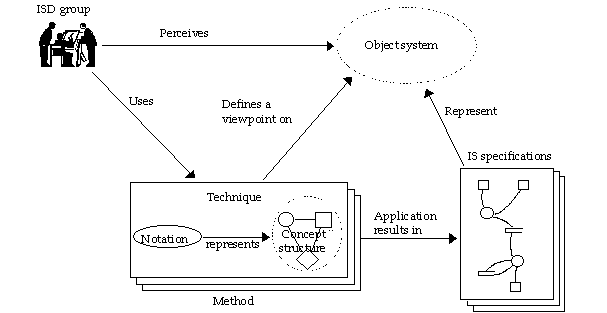2.1 Information system development methods
We define ISD as “a change process taken with respect to
object systems in a set of environments by a development group using
tools and an organized collection of techniques collectively
referred to as a method to achieve or maintain some objectives”
(Welke 1981, Lyytinen 1987). ISD is understood to include development of both
manual and computerized parts of an object system. An IS can therefore include
both manual and computer-supported parts. Although the definition emphasizes
essential components of ISD, such as its social nature and varying objectives,
in this thesis we shall mainly focus on the italicized parts of the definition,
i.e. on the role of methods and techniques, and their supporting tools.
By a technique we mean a set of steps and a set of
rules which define how a representation of an IS is derived and handled using
some conceptual structure and related notation (Smolander et al. 1990). Olle et
al. (1991) and Wijers (1991) call this knowledge a way of modeling. This
definition is illustrated in Figure 2-1. By using a technique, system developers
perceive, define and communicate on certain aspects of the current or desired
object system. These aspects are defined by the conceptual structure of the
technique and represented by the notation. By a tool we generally mean a
computer-based application which supports the use of a modeling technique.
Tool-supported modeling functionality includes abstraction of the object system
into models, checking that models are consistent, converting results from one
form of model and representation to another, and providing specifications for
review (Olle et al. 1991).
Examples of modeling techniques are data flow diagrams and
activity models. Other techniques can be found from Table 4-1. As a technique, a
data flow diagram identifies and names the objects (e.g. process, store) and
relationships (e.g. data flow, control flow) which it considers important in
developing an IS. Other techniques include other sets of objects and
relationships. Modeling techniques also have a notation and a representation
form. In a data flow diagram the notation for a process is a circle, and for a
data flow a solid line with an arrow-head. The representation form of a data
flow diagram is a graphical diagram. Furthermore, a technique defines some
principles on how the models should be derived (e.g. decomposition of processes
while modeling with data flow diagrams). In other words, a modeling technique
specifies which kind of aspects of an object system need to be perceived, in
what notation each aspect is represented, and how such representations should be
produced.
A
method can be considered as a predefined and
organized collection of techniques and a set of rules which state by whom, in
what order, and in what way the techniques are used (Smolander et al.
1990)
[8] to achieve or maintain some objectives.
In short, we call this method knowledge. Thus, our definition of method includes
both the product and process aspects, although dictionaries define the term
“method” as meaning “the procedure of obtaining an
object” (Baskerville 1996) and therefore emphasize the process rather than
the representation (i.e. product of the method use). In contrast, Wijers (1991)
notes that most ISD method text-books focus on feasible specifications rather
than on the process of how to develop such specifications. In addition, a method
also includes knowledge about method users, development objectives and values.
We will analyze the types of method knowledge in more detail in the next
section.
Examples of methods include Structured Analysis and Design
(SA/SD, Yourdon 1989a), and the object-oriented methods of Booch (1991) and
Rumbaugh et al. (1991). A short example of method knowledge is in order. The
method knowledge of SA/SD can be discussed in terms of the techniques (e.g. data
flow diagram, entity-relationship diagram) and their interrelations. In SA/SD
the overall view of the object system is perceived through a hierarchical
structure of the processes that the system includes. This overall topology is
completed by data transformations; how data is used and produced by different
processes, how it is transformed between processes, and where it is stored.
Moreover, the data used in the system needs to be defined in a data-dictionary
and interrelations between data need to be specified with entity-relationship
diagrams. Thus, methods describe not only how models are developed but also how
they are organized and structured. Furthermore, since ISD methods aim to carry
out the change process from a current to a desired state they should also
include knowledge for creating alternative design solutions and provide
guidelines to select among them (Tolvanen and Lyytinen 1994).

FIGURE 2-1 The role of methods in ISD (based on Lyytinen
et al. 1989).
SA/SD and other methods put forward a defined and a
limited number of techniques including their conceptual structures and
notations. In the same way as there is variety in techniques, there is also
diversity among methods (Welke and Konsynski 1980). Different methods include
different types and sets of techniques. Interrelations between techniques can be
defined differently even between methods which use the same techniques, and the
procedures for building and analyzing models can be different. Although there is
diversity among ISD methods they include similarities, e.g. they apply the same
concepts and notations. To understand these differences and similarities we
shall analyze several methods in more detail by describing types of method
knowledge.
[8] We aim to avoid the use of
methodology altogether; the use of this term has become confused as it
originally means the study of methods, but is also used as a synonym for a
method.





